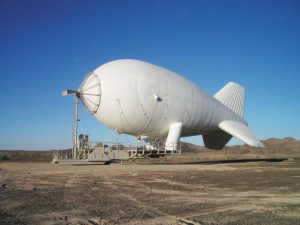
The Persistent Threat Detection Systems, fielded by Product Manager Robotics & Unmanned Sensors, provides Warfighters with a high level view of the battlefield. Photo Courtesy of U.S. Army
Thinking out of the box” is a term usually given to those that come up with a new and dynamic approach to a problem. However, there are times when the creative solution is not to develop something completely new, but to borrow from previously proven ideas and apply the best that modern technology has to offer.
Since the Civil War, when Union soldiers utilized hot air balloons to serve as a surveillance platform, lighter than air technology has been a part of the US Army’s inventory. As U.S. forces begin a troop surge in Afghanistan while maintaining security in Iraq the need to provide soldiers with a persistent view of the battlefield is paramount.
As a part of the Secretary of Defense’s directed intelligence, surveillance and reconnaissance (ISR) surge one of the ways the Program Executive Office, Intelligence, Electronic Warfare & Sensors (PEO IEW&S) is providing soldiers with the ability to understand their environment with the use of the Persistent Threat Detection System (PTDS).
PTDS is a large aerostat tethered to a mooring platform, which is accompanied by a ground control station (GCS). The system is equipped with both visual and audio surveillance technology.
“The great thing about the PTDS is that it delivers protection to Soldiers, Sailors, Airmen and Marines with its ability to provide persistent surveillance against potential threats over a wide area both
day and night,” said Lt. Col. Terrence L. Howard, Product Manager Robotic & Unmanned Sensors (PdM RUS). “Utilizing multiple sensors, the system delivers images to decision makers in near real-time full motion video allowing for eyes on target.”
PTDS acts as a force multiplier for commanders on the ground as it can be utilized to scan large areas of terrain for potential insurgent activity while interacting with various other sensors to give a complete picture of potential threats. Information collected by the system is distributed to soldiers via various routes including the Distributed Common Ground System-Army (DCGS-A); which is an intelligence tool.
Convoy protection, counter-IED and a real-time perspective of engagements with the enemy are amongst the roles PTDS play for troops on the ground. “The solider deserves to have an awareness of what is happening on the ground and to do that they need a mix of capabilities,” noted Howard.
The system operates 24 hours a day utilizing a crew of five operators working 12 hours shifts. With an ability to reach heights of one mile, PTDS offers the user a vast perspective of the battlefield while remaining out of the range of most enemy threats.
Originally fielded as a quick reaction capability (QRC) in 2004 the systems are now located at various forward operating bases throughout Afghanistan and Iraq and have become more prevalent as the Army has increased its focus on ISR assets.